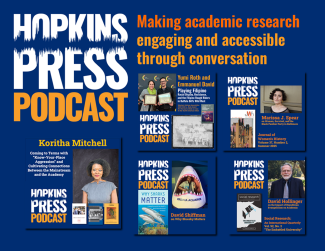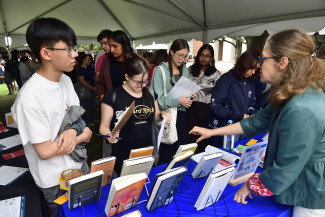
Johns Hopkins UniversityEst. 1876
America’s First Research University
Harlem World: A Hip Hop Playlist through History

July 3, 1981, was a pivotal night for the future of America's newest art form: hip hop. In New York's Harlem World Club, the Fantastic Romantic Five and the Cold Crush Brothers competed, with an unprecedented $1,000—and their reputations—on the line in a highly anticipated rap battle. The show drew hundreds of fans to settle a question that still dominates hip hop circles: Who's the best? In Harlem World, journalist Jonathan Mael chronicles this fateful night of hip hop rivalry and shares a new look at how Harlem helped ignite a musical revolution. Mael curated a playlist of songs, linked below, to listen to while you read the book.
"When reading my book, I hear these songs as I flip the pages," Mael said. "They were playing in my headphones as I wrote the manuscript. Hip hop was still growing up in the summer of 1981, even though some artists had broken through into the mainstream music industry. Among the genre’s originators, however, hip hop remained a strictly live medium. All of these songs are directly related to the era covered in Harlem World. Even though they are extremely diverse in genre, instrumentation, and tempo, they are a great representation of a simple fact—hip hop was and remains a genre that defies a single definition. When music is made by using the best of other music and whatever resources are available, creativity is the only key. In hip hop, the most important instrument is the mind, and each of these songs was chosen to highlight that."
The Harlem World Playlist
Below, Mael muses on each of the songs in this playlist and offers behind-the-scenes information on music that helped define the origins of hip hop.
Square Biz – Teena Marie
The beginning of this raucous disco standard was the break that Grand Wizzard Theodore chose to kick off the Fantastic Romantic Five’s routine at the July 3rd, 1981 Battle at Harlem World. The “HEE!” and “everybody get up” lines were perfect to match the energy and anticipation in the room in the moments before Fantastic hit the stage.
Bongo Rock – Incredible Bongo Band
This 1973 instrumental release was one of the first breaks that DJ Kool Herc and his contemporaries extended at their initial hop hop parties. The simple percussion patterns and fast tempo made this a popular choice for early breakdancers to show off their moves and for the original emcees to say their rhymes over.
I Write The Songs – Barry Manilow
At first glance, this crooning, orchestral ballad seems like the last place you’d look to find hip hop history. However, Grandmaster Caz has cited Manilow as one of his major inspirations. There was only one radio station Caz could listen to as a young kid and he fell in love with Simon and Garfunkel, Manilow, Cat Stevens, and The Rolling Stones alongside Motown and disco acts. One of Cold Crush’s routines follows a melody similar to I Write the Songs.
Cat's in the Cradle – Harry Chapin
This soft rock standard is an example of what set the Cold Crush Brothers apart – using familiar melodies across genres to build routines. At Harlem World on July 3rd, 1981, one of Cold Crush’s routines, “Other Emcees” was set to the tune of Cats in the Cradle. Grandmaster Caz still considers that melody to be one of his favorites.
Good Times – Chic
The genius of Nile Rodgers and his bandmates wielded a heavy influence on early hip hop. The thumping bassline in this song was one of the most popular “breaks” at block parties and park jams in the 1970s. Grandmaster Flash and Grandwizzard Theodore both applied their new spinning techniques to this record but it is most famous for providing the breakbeat for the first commercially successful hip hop record, Rapper’s Delight
Rapper’s Delight – The Sugarhill Gang
Widely recognized as the record that gave birth to mainstream hip hop, this lengthy legendary track turned the quickly thrown together Sugarhill Gang into household names in 1979. The group formed outside of the Crispy Crust Pizzeria in Englewood, New Jersey at the request of record executive and former soul star Sylvia Robinson. Big Bank Hank infamously used lyrics written by his associate Grandmaster Caz on the record. The general public loved the song but the hip hop founders, including Caz himself, panned it.
Christmas Rappin’ – Kurtis Blow
On the heels of the success of Rapper’s Delight, Harlem native Kurtis Walker (Kurtis Blow on stage), struck gold with Christmas Rappin’ in the winter of 1979. The first emcee signed to a major label, Blow released his single via Mercury Records and it was such a sensation that radio stations played it well into the following spring.
Love Rap – Spoonie Gee
This 1980 release was one of the best examples of the early rhyming styles in hop hop. Harlem’s Spoonie Gee told a vivid story through his verses while still doing playful call and response party lines. Gabriel Jackson (as he’s known offstage) was a peer of the Cold Crush and raps with a similar attacking flow as the four emcees. Love Rap has the distinction of being the only breakbeat that both Fantastic and Cold Crush used at their July 3rd, 1981 battle at Harlem World. Grandmaster Caz’s triumphant “Yvette” routine is set to Love Rap.
Fantastic Freaks at the Dixie – Fantastic Romantic Five
This performance appeared on the soundtrack for Wild Style and is perhaps the best recording of a Fantastic show. Each of the five emcees showed off his verbal skills and signature lines (and in the film, his signature style). Theodore had a complete mastery of the turntables and actually supplied much of the music for the film. Director Charlie Ahearn said that he set up the scene to be as close to a natural performance as possible, so the recording is an authentic look at what Fantastic shows were like.
Cold Crush Brothers at the Dixie – Cold Crush Brothers
Cold Crush’s performance in Wild Style was shown quickly after Fantastic’s. Under Ahearn’s direction, the group was free to bring their tried and true routines to the film. The result was a thunderous, energetic performance. Grandmaster Caz’s solo, his “Yvette” story, remains one of the most lyrically clever verses in hip hop history more than forty years later.
Rapture – Blondie
In 1980, Debbie Harry, Chris Stein, and company were enthralled with hip hop culture, finding so many commonalities between Blondie’s downtown punk rock roots and the new genre making waves in the Bronx and Harlem. In one of the strangest cases of musical fusion on record, Blondie released Rapture, a hip hop song that crossed over to radio stations across the country. For many people, the first time they heard Grandmaster Flash’s name is through Harry’s mouth, saying “Flash is fast, Flash is cool…” While from an unlikely messenger, the song did have a massive positive impact for hip hop as it was now reaching a new audience.
The Message – Grandmaster Flash and the Furious Five
Arguably the most important song in the history of the genre, The Message was the first hip hop song to address serious topics and issues through the rhyming. Party routines had given way to narrative storytelling (like Caz’s “Yvette” verse) by 1982, but Melle Mel’s lyrics about issues like poverty, incarceration, and drugs were revolutionary and steered the genre in a new direction.
Jonathan Mael is a high school teacher and reporter. He is the author of Harlem World: How Hip Hop's Super Showdown Changed Music Forever.


